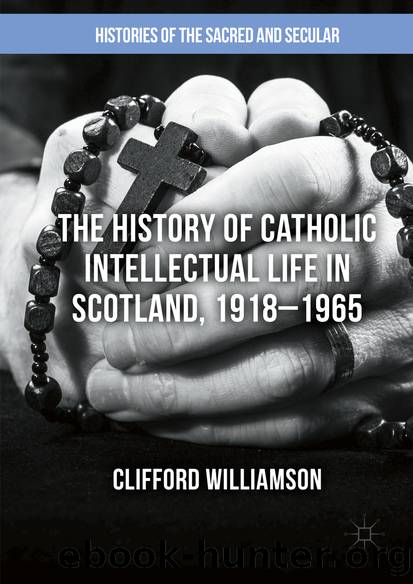The History of Catholic Intellectual Life in Scotland, 1918â1965 by Clifford Williamson

Author:Clifford Williamson
Language: eng
Format: epub
Publisher: Palgrave Macmillan UK, London
Marianism in Scotland
The central importance of the Virgin Mary in Catholic theology and iconography had been recognised for centuries.19 A little less well recognised has been the significance of Marian devotion in Scotland. An important step in recovering the history of Marianism in Scotland came in 1954, the year that brought to a close Pope Pius IXâs âMarian Centuryâ, through an article published in the St Peterâs College Magazine by Mgr David McRoberts entitled Scotland and Our Lady.20 The article examined each of the periods of the Catholic history of Scotland and brought forward examples of Marian devotion in the culture and piety of Scotland. McRoberts argued that far from being immune from Marian imagery, as many post-Reformation scholars suggested, âthat in every phase and aspect of Christian life, the medieval and the modern Catholics of Scotland prove themselves to be as sincere and devout clients of Our Lady as any other national group within the comity of nations that we call Christendomâ.21
Starting with Celtic Christianity, the period prior to the Clunaic Reformation22 of the eleventh century, although feast days celebrating Mary and the saints were uncommon, McRoberts argued âthat primitive devotion to Our Lady is writ large on the face of the whole countryâ,23 through many place names from this period which contain Mary or Mother or Lady in their titles such as Tobermory (âmoryâ is the old Scottish variation of Mary), Motherwell and Ladywell amongst many other examples.24 From the eleventh century to the Reformations of the late sixteenth century, Scottish Mariology developed on the same pattern as the rest of Catholic Christendom. The Virgin Mary was celebrated in art, song, poems and in the devotional preferences of Scots. McRoberts used as an example the fairs and holidays of the Scottish parishes. Out of 300 known Scottish fairs, over 40 were held in honour of Mary.25 In many churches, Saturday services were dedicated to Maryâs honour.26 Many Scottish Catholics from the latter Middle Ages onwards said the Rosary to the Virgin.27 Following the sixteenth-century Reformation almost all of the statues, shrines and images of Mary were ransacked, torn down or destroyed by zealots and looters: only one of the medieval statues to the Virgin survives to this day. In Brussels at the church of Finisterre, the Statue to Our Lady of Good Success was originally called Our Lady of Aberdeen. The statue was removed from the city and secretly transported to the Low Countries.28 In the years after the Reformation in Scotland, Marian devotion was still maintained by recusant Catholics. McRoberts cited two examples from Aberdeen and Speyside of processions and holidays dedicated to the Virgin surviving well into the seventeenth century.29 The final examples of Marian tradition in Scotland were in heraldry. (McRoberts had a long-standing interest in heraldry and he designed the coats of arms for the Scottish Catholic dioceses in 1945 and in 1960 for the moderator of the Presbyterian Church of Scotland.)30 Many of the burgh emblems and noble coats depict images of the Virgin Mary.
Download
This site does not store any files on its server. We only index and link to content provided by other sites. Please contact the content providers to delete copyright contents if any and email us, we'll remove relevant links or contents immediately.
Resisting Happiness by Matthew Kelly(2913)
The Social Psychology of Inequality by Unknown(2347)
Designing Your Life by Bill Burnett(2309)
Day by Elie Wiesel(2267)
The Giving Tree by Shel Silverstein(1868)
Angels of God: The Bible, the Church and the Heavenly Hosts by Mike Aquilina(1648)
Human Design by Chetan Parkyn(1598)
Augustine: Conversions to Confessions by Robin Lane Fox(1486)
The Supreme Gift by Paulo Coelho(1469)
Hostage to the Devil by Malachi Martin(1416)
Jesus of Nazareth by Joseph Ratzinger(1410)
7 Secrets of Divine Mercy by Vinny Flynn(1408)
Dark Mysteries of the Vatican by H. Paul Jeffers(1367)
The Vatican Pimpernel by Brian Fleming(1359)
St. Thomas Aquinas by G. K. Chesterton(1333)
Saints & Angels by Doreen Virtue(1324)
My Daily Catholic Bible, NABRE by Thigpen Edited by Dr. Paul(1223)
Called to Life by Jacques Philippe(1216)
The Ratline by Philippe Sands(1186)
